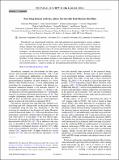Files in this item
Non-Ising domain walls in c-phase ferroelectric lead titanate thin films
Item metadata
| dc.contributor.author | Weymann, Christian | |
| dc.contributor.author | Cherifi-Hertel, Salia | |
| dc.contributor.author | Lichtensteiger, Céline | |
| dc.contributor.author | Gaponenko, Iaroslav | |
| dc.contributor.author | Dorkenoo, Kokou Dodzi | |
| dc.contributor.author | Naden, Aaron B. | |
| dc.contributor.author | Paruch, Patrycja | |
| dc.date.accessioned | 2023-01-09T14:30:09Z | |
| dc.date.available | 2023-01-09T14:30:09Z | |
| dc.date.issued | 2022-12-20 | |
| dc.identifier | 282860547 | |
| dc.identifier | 95c6fe34-e9f6-4030-bf26-da350e6e2729 | |
| dc.identifier | 85144618897 | |
| dc.identifier | 000905282200008 | |
| dc.identifier.citation | Weymann , C , Cherifi-Hertel , S , Lichtensteiger , C , Gaponenko , I , Dorkenoo , K D , Naden , A B & Paruch , P 2022 , ' Non-Ising domain walls in c -phase ferroelectric lead titanate thin films ' , Physical Review B , vol. 106 , no. 24 , L241404 . https://doi.org/10.1103/PhysRevB.106.L241404 | en |
| dc.identifier.issn | 2469-9950 | |
| dc.identifier.other | RIS: urn:5BE3E2C6020347DABA9296F7021DF127 | |
| dc.identifier.other | ORCID: /0000-0003-2876-6991/work/126554464 | |
| dc.identifier.uri | https://hdl.handle.net/10023/26721 | |
| dc.description | Funding: This work was supported by Division II of the Swiss National Science Foundation under Project No. 200021_178782. A.B.N. gratefully acknowledges support from the EPSRC (Grants No. EP/R023751/1 and No. EP/L017008/1). S.C.-H. acknowledges the support of the French Agence Nationale pour la Recherche (ANR) through Grant No. ANR-18-CE92-0052 and the Programme d'Investissement d'Avenir ANR-10-IDEX-0002-02 of the University of Strasbourg under Contract No. ANR-11-LABX-0058_NIE. C.L. acknowledges the support from Division II of the Swiss National Science Foundation under Project No. 200021_200636. | en |
| dc.description.abstract | Ferroelectrics are technologically important, with wide application in micromechanical systems, nonlinear optics, and information storage. Recent discoveries of exotic polarization textures in these materials, which can strongly influence their properties, have brought to the forefront questions about the nature of their domain walls: long believed to be primarily Ising, with locally null polarization. Here, combining three complementary techniques - second-harmonic generation microscopy, piezoresponse force microscopy, and transmission electron microscopy - to cover all the relevant length scales, we reveal the Néel character (non-Ising polarization oriented perpendicular to the wall) of 180° domain walls in c-phase tetragonal ferroelectric lead titanate epitaxial thin films, for both artificial and intrinsic domains at room temperature. Furthermore, we show that variations in the domain density - detected both optically and via local piezoresponse and then quantified by radial autocorrelation analysis - can give us insight into the underlying defect potential present in these materials. | |
| dc.format.extent | 8 | |
| dc.format.extent | 4664634 | |
| dc.language.iso | eng | |
| dc.relation.ispartof | Physical Review B | en |
| dc.subject | QD Chemistry | en |
| dc.subject | QC Physics | en |
| dc.subject | DAS | en |
| dc.subject | MCC | en |
| dc.subject.lcc | QD | en |
| dc.subject.lcc | QC | en |
| dc.title | Non-Ising domain walls in c-phase ferroelectric lead titanate thin films | en |
| dc.type | Journal item | en |
| dc.contributor.sponsor | EPSRC | en |
| dc.contributor.sponsor | EPSRC | en |
| dc.contributor.institution | University of St Andrews. Institute of Behavioural and Neural Sciences | en |
| dc.contributor.institution | University of St Andrews. School of Chemistry | en |
| dc.identifier.doi | 10.1103/PhysRevB.106.L241404 | |
| dc.description.status | Peer reviewed | en |
| dc.identifier.grantnumber | EP/R023751/1 | en |
| dc.identifier.grantnumber | ep/l017008/1 | en |
This item appears in the following Collection(s)
Items in the St Andrews Research Repository are protected by copyright, with all rights reserved, unless otherwise indicated.

